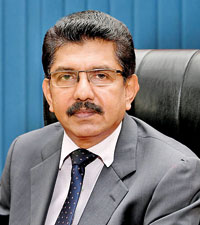News
Environment Ministry Secretary outlines climate protection moves
View(s):Sri Lanka is only responsible for 0.03 percent of the world’s green-house gas emissions and yet it is one of the countries identified as most vulnerable to the effects of climate change. It is ranked 2nd in the Global Climate Risk Index for 2019 and 6th for 2020.
“Sri Lanka is more vulnerable to climate change because our ability to withstand the consequent natural disasters and invest in the mitigation of these effects is limited,” said Dr. Anil Jasinghe, Secretary to the Ministry of Environment.

Environement Ministry Secretary Anil Jasinghe: Sri Lanka’s energy goals aim to achieve 70 percent power generation through renewable energy sources
Internal migration, natural disasters, and lack of consistent irrigation are all by-products of a deteriorating climate, according to the secretary. “As people move away from dry zones and move towards wet zones, the already congested areas will become uncontrollably overpopulated.”
About 95% of Sri Lanka’s biodiversity is contained in the country’s wet zone even though the dry zone is a larger area. Environmental imbalances lead to increased floods, droughts and other extreme weather conditions. Apart from the damage to life and property, the inconsistent weather conditions also impact the agricultural industry as inconsistent rainfall affects irrigation, he said
Pointing out that island nations such as the Maldives were at risk of sinking as sea levels rose, the Secretary noted that while no official statistics were available, there were signs in some locations around Sri Lanka as well.
The Presidential Task Force on Creating a Green Sri Lanka with Sustainable Solutions to Climate Change was reformulated just last week and Environment Minister Mahinda Amaraweera was appointed as Chairman with Ministry Secretary Dr. Anil Jasinghe as the Secretary. The task force is set to explore the implementation of Sri Lanka’s Nationally Determined Contributions (NDCs) which are currently divided into Mitigation Sectors and Adaptation Sectors. Commitments under the mitigation sectors involve measures to reduce harmful practices followed by the power and energy, transport sector, industrial and other sectors.
According to Dr. Jasinghe, Sri Lanka’s energy goals were to achieve 70 percent power generation through renewable energy sources such as hydro-power, wind power and solar energy. The closure of the Norochcholai plant and the no-more coal policy are moves in this direction. Agrochemical bans and the move towards organic fertiliser are also being implemented. The Ministry recently rolled out single-use plastic ban. It is also focusing on E-mobility, with feasibility studies being conducted for the implementation of electronic public transport while a committee has been appointed to conduct research following cabinet approval.
However, an underutilisation of resources exists, the secretary pointed out. While forest cover is recognised as vitally important for environment-saving efforts, questionable policy decisions of the past have contributed to its rapid depletion. No official research is done into the impacts that certain policy decisions may have on the environment. For example, no situational analysis nor impact assessments have been conducted since the reversal of the 5/2001 circular which delegated the authority to distribute state forests to local government.
“We have bodies such as the Climate Change Secretary and the Sri Lanka Climate Fund that have the resources to conduct researches but they have not been employed that way,” Dr. Jasinghe admitted. He attributed this shortfall to the lack of interest shown by previous administrations.
“The industrial revolution that brought developed countries to where they are was what sparked the increase of greenhouse gas emissions into our atmosphere. Unfortunately developing countries have to combat these impacts while trying to improve their economies,” the secretary noted.
Mr. Jasinghe said developing nations such as Sri Lanka, could overcome these challenges by utilising funds to develop infrastructure. For example, the water scarcity problem could be solved through infrastructural development aimed at transporting water from excess water areas to areas without water.
The Green Climate Fund (GCF) was introduced to mitigate the injustice in the global system and developed countries pledge USD 100 billion annually to assist developing countries to achieve their sensitive socioeconomic goals.
However, Dr. Jasinghe said that the promise was rarely honored. He noted that the process of obtaining this aid was so complicated that “accessing this fund is virtually impossible.”
The processes need to be simplified so that it can go towards helping the countries that are trying to move forward without contributing to climate change, he said noting that this was brought up during the Ministry’s recent meeting with COP26 Regional Ambassador Mr. Ken O’Flaherty.

